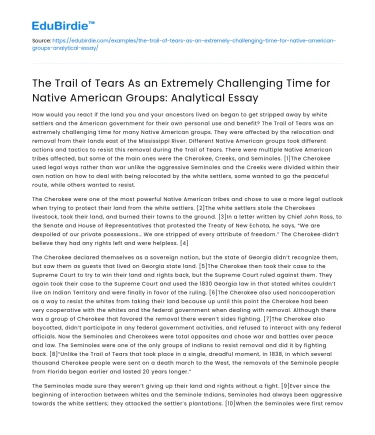How would you react if the land you and your ancestors lived on began to get stripped away by white settlers and the American government for their own personal use and benefit? The Trail of Tears was an extremely challenging time for many Native American groups. They were affected by the relocation and removal from their lands east of the Mississippi River. Different Native American groups took different actions and tactics to resist this removal during the Trail of Tears. There were multiple Native American tribes affected, but some of the main ones were the Cherokee, Creeks, and Seminoles. [1]The Cherokee used legal ways rather than war unlike the aggressive Seminoles and the Creeks were divided within their own nation on how to deal with being relocated by the white settlers, some wanted to go the peaceful route, while others wanted to resist.
The Cherokee were one of the most powerful Native American tribes and chose to use a more legal outlook when trying to protect their land from the white settlers. [2]The white settlers stole the Cherokees livestock, took their land, and burned their towns to the ground. [3]In a letter written by Chief John Ross, to the Senate and House of Representatives that protested the Treaty of New Echota, he says, “We are despoiled of our private possessions… We are stripped of every attribute of freedom.” The Cherokee didn’t believe they had any rights left and were helpless. [4]
Save your time!
We can take care of your essay
- Proper editing and formatting
- Free revision, title page, and bibliography
- Flexible prices and money-back guarantee
The Cherokee declared themselves as a sovereign nation, but the state of Georgia didn’t recognize them, but saw them as guests that lived on Georgia state land. [5]The Cherokee then took their case to the Supreme Court to try to win their land and rights back, but the Supreme Court ruled against them. They again took their case to the Supreme Court and used the 1830 Georgia law in that stated whites couldn’t live on Indian Territory and were finally in favor of the ruling. [6]The Cherokee also used noncooperation as a way to resist the whites from taking their land because up until this point the Cherokee had been very cooperative with the whites and the federal government when dealing with removal. Although there was a group of Cherokee that favored the removal there weren’t sides fighting. [7]The Cherokee also boycotted, didn’t participate in any federal government activities, and refused to interact with any federal officials. Now the Seminoles and Cherokees were total opposites and chose war and battles over peace and law. The Seminoles were one of the only groups of Indians to resist removal and did it by fighting back. [8]“Unlike the Trail of Tears that took place in a single, dreadful moment, in 1838, in which several thousand Cherokee people were sent on a death march to the West, the removals of the Seminole people from Florida began earlier and lasted 20 years longer.”
The Seminoles made sure they weren’t giving up their land and rights without a fight. [9]Ever since the beginning of interaction between whites and the Seminole Indians, Seminoles had always been aggressive towards the white settlers; they attacked the settler’s plantations. [10]When the Seminoles were first removed from their land after the Indian Removal Bill in 1830 was passed they chose to fight and protect their land instead of lying over and letting the white settlers take it from them.[11]During the second Seminole war the Seminole leader Osceola led his men to two victories against the American troops before being captured and dying while imprisoned.[12] After he died some of his best man escaped and were hunted down by American soldiers, but once the troops finally caught up to the escapees they had already made a ban of over a few hundred Indians that were waiting on the American troops and ambushed them. [13]One of the American Generals who had arrived at the battlefield after the battle wrote, “The Indians had not disturbed them, except by taking the scalps of most of them.” This quote from the General shows how little sympathy the Seminoles had for the Soldiers they just killed and how brutal they really were. The Seminoles were a strong group of people that believed their land and rights couldn’t be taken away from them especially if they could do something about it.
The Creek Indians were alike the Cherokee and the Seminoles both, they were divided within their own Nation on how to deal with being relocated by the white settlers. [14]Some wanted to resist removal while others believed removal would be beneficial for both the Americans and the Creeks. [15]These two different views eventually led to a civil war and the “Red Sticks” who wanted to resist removal attacking creeks who agreed with removal and settlers. [16]This then led to an attack on the Red Sticks by American troops that ended with the Indians signing the Treaty of Fort Jackson in 1814. [17]Then there was the group of loyalists who wanted to resist removal, but didn’t want to fight, but use most legal matters. [18]They went to D.C. to try to nullify the Treaty of Indian Springs, which took a huge portion of land from the Creeks and gave it to the Government and white settlers. [19]They succeeded and got the Treaty overturned, but still ended up losing a lot of their land. [20]Then there was the last group who didn’t want to resist at all and migrated voluntarily. [21]They either didn’t want a confrontation with the American government or were intimidated by the white settlers who stole their land.






 Stuck on your essay?
Stuck on your essay?

